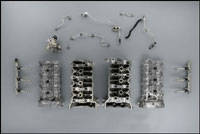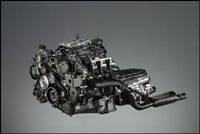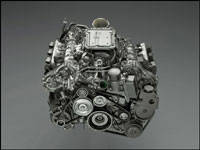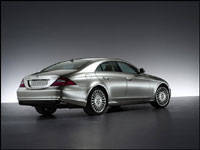The use of piezoelectric injectors, as opposed to regular fuel
 |
| Some of the engine's components were re-worked for heavier duty use. The engine must deal with up to 2,900 psi! (Photo: Mercedes-Benz Canada) |
injectors changes key elements of the combustion process. By nature, piezo injectors are precision components, designed to deliver an extra-fine spray of fuel. Combined with their ultra-quick change of state, and a fuel-line pressure over 200 bar (2,900 psi - some 50 times greater than a normal fuel injection system), fuel delivery 'strokes' are optimal and consistent. What is unique about Benz's CGI system is that through the use of piezoelectrics, fuel can be delivered to the engine multiple times during the combustion cycle and not just at one point. This allows for further improvements on power and torque, all while reducing emissions and overall waste gasses.
The
 |
| CGI system is able to run lean, even in times when others can't. (Photo: Mercedes-Benz Canada) |
fuel savings generated by direct injection engines come from their unique ability to run lean, a term used to describe a mixture of gasoline and air that is used for combustion. The injection spray in any direct injection system is ultra-fine and evenly distributed, allowing the engine to run lean, but under high compression. As a result, less fuel is used and therefore fewer emissions are produced. CGI moves the game up one step further with multiple-stage injection. The majority of direct injection systems only run on lean mode when engine loads are low, such as during low-speed cruising. The CGI's multistage injection provides sufficient power and torque to ensure that the car can run lean during acceleration, and sustain that lean fuel to air mixture at speeds above 120 km/h.
As it now seems, the payoff for Mercedes playing the waiting game
 |
| 292-horsepower and 269 lb-ft of torque are generated by the improved engine. (Photo: Mercedes-Benz Canada) |
has been well worth it, with results that are well beyond expectations when compared to the standard 3.5-litre V6. All things considered, the automaker's 3.5-litre V6 engine is a respectable power source, and can be found extensively throughout the Mercedes-Benz range in everything from its C-Class sedan to the ML-Class SUV. In current production guise it makes 272-horsepower and 258 lb-ft of torque, but adding the revised CGI injection system to the same engine generates more power and more torque, delivering 292-horsepower and 269 lb-ft of torque. And it gets better, as fuel consumption is down to as little as 9.1 L/100 km from 10.1 L/100 km on a mix of city and highway. The CGI version of the CLS is also quicker to 100 km/h by 0.3 seconds, taking just 6.7 seconds.
Having positioned itself on the cutting edge of diesel technology
 |
| The CLS350 CGI will replace the standard CLS350 in Western Europe. Will Benz do the same with 3.5-litre models in North America? (Photo: Mercedes-Benz Canada) |
with Bluetec, and now gasoline direct injection with CGI, Mercedes-Benz has returned to its tradition of perfection through innovation. Mercedes intends to replace the standard CLS350 with the new CLS350 CGI model, and eventually will phase out the non-CGI versions of other cars in favour of this powerplant. In the not too distant future, it's also expected that Mercedes will add CGI to its smaller V6s and to its V8s as well. There's been no word on whether Benz will offer CGI in North America, but with better quality fuels on the way and many competitors offering direct injection gasoline engines, it's only a matter of time.










